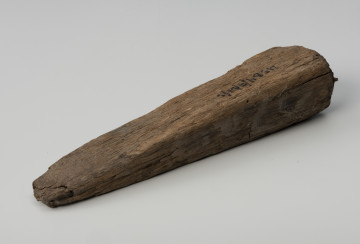
Long comb
1176 — 1225
National Museum in Szczecin
Part of the collection: Middle Ages
An adze discovered in unknown circumstances in Widuchowa (formerly Fiddichow), Gryfino district, which ended up in the collection of the Pomeranian Museum in Szczecin (Pommersches Landesmuseum in Stettin), which operated between 1927 and 1945. This tool was forged from an iron billet by a blacksmith – a specialised craftsman. The first step in the complex metallurgical process involved finding a suitable raw material. In the early Middle Ages, iron was obtained from bog ore. Special furnaces were used by ore smiths to burn the ore in order to obtain iron, which would be then processed in forges, where blacksmiths made tools and weapons, as well as ornaments. A common blacksmithing practice was to refine the raw material by so-called quenching, which involved heating the metal until red-hot, and then quickly cooling it in cold water. Quenched iron was harder and more damage-resistant. More complicated tasks included welding two pieces of iron, or sometimes iron and steel, together. Iron was often enriched by the process known as carburising. The iron adze from Widuchowa is a small-sized tool with a round ferrule for installing it on a wooden handle. Both sides of the blade show evidence of welding from at least two pieces of raw material. The tool was used for woodworking by carpenters, coopers, wheelwrightis and boatbuilders.
Grzegorz Durdyń
Other names
adze
Author / creator
Dimensions
cały obiekt: height: 9.3 cm, width: 3.3 cm
Object type
adze, carpentry tool
Technique
forging
Material
iron
Origin / acquisition method
acquisition
Creation time / dating
Creation / finding place
Owner
Muzeum Narodowe w Szczecinie
Identification number
Location / status

1176 — 1225
National Museum in Szczecin

1176 — 1200
National Museum in Szczecin

901 — 1200
National Museum in Szczecin
DISCOVER this TOPIC
National Museum in Lublin
DISCOVER this PATH
Educational path